JPMorgan Admits It Was Wrong About End Of Bitcoin Bull Run, Renews $140,000-Plus Price Forecast
At the time of this writing, the cryptocurrency known as Bitcoin (BITCOMP) has seen its value skyrocket to around $19,000 after dropping down to around just $4,840 in mid-March. This is significant because the all-time high for the cryptocurrency is $19,783 from back in December of 2017, only for it to drop down to as low as $3,122.
Within the past year, the price of Bitcoin has more than doubled, posting close to $10,000 in growth in the last two months alone. As Ethan Yang writes at The American Institute for Economic Research, with most of the news attention on COVID-19, the presidential election, and so on, it is understandable that the meteoric rise of Bitcoin may have slipped past casual observers, as it did not receive the attention it received in 2017.
However, what makes this rapid growth interesting is that there are a number of important circumstances that might be paving the way for Bitcoin to sustain its ongoing trend.
Quantitative Easing Worldwide
It is undeniable that the monetary limits of fiat currency are being tested around the world as governments print trillions of dollars for stimulus packages in reaction to COVID-19. The World Resources Institute writes:
In response to the massive economic contraction stemming from the coronavirus (COVID-19) pandemic, some central banks — including those of the United States, European Union, Japan and other major economies — are engaging in 'quantitative easing' (QE) programs on an unprecedented scale.
The United States alone has printed trillions of dollars and has far outspent what it has brought in with tax dollars, creating an unprecedented level of debt. Forbes writes:
For the first time U.S. debt is now about equal to GDP (Gross Domestic Product), like the sound barrier that we once thought might explode if hit.
This level of spending and money creation has likely driven many investors to Bitcoin, as it may serve as a safe haven as the value of fiat currencies like the US dollar comes into question. Furthermore, it is uncertain how the stock market, which has been the main beneficiary of quantitative easing, will react when such policies eventually subside.
Since the 2008 recession, money injections from the Federal Reserve have continued at a constant rate and the value of the S&P 500 has moved in step with spending. This creates a disconnect between financial markets and the actual productiveness of the economy. Bitcoin may serve as an alternative investment vehicle for those who are wary of an unsustainable securities market.
An article in MarketWatch explains:
Worries that governments are printing heaps of money to paper over problems created partly by the 2008 financial crisis was at least part of the reason that bitcoins were created over a decade ago. That thinking is also the basis for this resurgence in bitcoin, crypto experts said, as the COVID-19 pandemic forces governments and central banks to spend to limit the economic hit.
Such caution is not unfounded, as the Federal Reserve’s balance sheet has ballooned to unprecedented levels in the past few months, going from $4.31 trillion to $7.18 trillion. The monetary policies post-2008 kicked off interest in cryptocurrencies, and it would not be irrational to assume that the current policies would be encouraging an accelerated timeline for the adoption of Bitcoin.
Mainstream Adoption of Cryptocurrencies
Perhaps the most significant development that may be supporting a potential sustainable growth trend for Bitcoin is the ongoing adoption of cryptocurrencies. Market Insider reports that major companies like PayPal (PYPL) are making moves to incorporate cryptocurrencies into their services, as they write:
PayPal recently said that users on its platform will be able to purchase bitcoin, as well as other sister cryptos like ethereum, Bitcoin Cash and Litecoin. PayPal’s decision last month was a further recognition of the legitimacy of digital currencies, crypto enthusiasts say.
'Today bitcoin has gotten to a place where institutional investors, banks, and family offices are legitimately pondering involvement as a defense against currency devaluation,' wrote Alex Mashinsky, CEO of Celsius Network, in emailed commentary.
'This isn’t a gold rush anymore, it’s a good investment,' he said. He predicts that bitcoin will hit $30,000 by the end of next year.
Perhaps one of the main dangers of cryptocurrencies is the fact that, at the moment, they are difficult to use and are rarely accepted anywhere. A lack of mainstream adoption may have explained the rapid fall of Bitcoin in 2017, as market hype diminished and investors understood that there was not much real value at the time. With the ongoing adoption of Bitcoin by major firms like PayPal, the growing value of Bitcoin may actually be justified.
PayPal isn’t the only company to move towards cryptocurrency. CNBC reports:
Payment company Square is buying a large block of bitcoin, an unusual use of corporate cash.
Square said Thursday it bought 4,709 bitcoins, worth approximately $50 million. This represents about 1% of Square’s total assets as of the end of the second quarter of 2020.
'Square believes that cryptocurrency is an instrument of economic empowerment and provides a way for the world to participate in a global monetary system, which aligns with the company’s purpose,' the company said in a release.
Not only does Square (SQ)’s investment in Bitcoin demonstrate ongoing adoption by relevant financial tech firms, it also highlights one of the key benefits of Bitcoin. This benefit is that it provides a universal and discreet form of value that individuals all around the world can access. Bitcoin is not only easy to transfer, but it is largely immune to manipulation, which makes it ideal for those who live in countries with less reliable monetary regimes.
Even large established banks like JP Morgan (JPM) are starting to experiment with cryptocurrencies as Yahoo Finance reports:
Indeed, at the DealBook Summit on Nov. 18, (Jamie) Dimon said, 'The blockchain itself will be critical to letting people move money around the world cheaper. We will always support blockchain technology.'
In May, JPMorgan went a step further when it began allowing customer transfers to and from Coinbase and Gemini, two U.S.-based regulated crypto exchange sites. And Dimon on Wednesday acknowledged that some 'very smart people' are investing in bitcoin these days.
This stands in contrast to his comments in 2017 where CNBC reports:
In September 2017, about three months before bitcoin hit an all-time high of nearly $20,000 per unit and crashed shortly thereafter, Dimon dropped a bomb on the crypto world. He called bitcoin a 'fraud.'
Cryptocurrency and blockchain technologies seem to be demonstrating undeniable advantages that cannot be ignored for long. These technologies will likely continue to grow in use, which gives further support to the ongoing growth of Bitcoin. Market Insider reports that one person in particular, billionaire Mike Novogratz, believes that Bitcoin could be heading as high as $65,000.
With unprecedented levels of quantitative easing and debt, combined with gradual mainstream adoption, it should not be controversial to say that Bitcoin might have some substance to back its meteoric revival. It is highly likely that in 2017 the world needed a couple more years to get acclimated to the idea of cryptocurrencies. It seems that for the most part they are here to stay and they will likely see further use.
But, as Ethan Yang notes, there is some room for caution. With all of the above said, it does not mean that Bitcoin and cryptocurrencies in general are guaranteed, or even likely, to continue on their current growth path.
Much like 2017, it is highly likely that market hype is a contributing factor to the growth of Bitcoin and it remains to be seen how far investors are willing to take this bull run. It is uncertain how much, if at all, the price of Bitcoin may drop or where its next peak will be. It could be at $20,000, or it could be at $65,000, or it could just keep going.
Market Insider cites billionaire investor Ray Dalio when he notes that cryptocurrencies are still far from attaining widespread adoption and that governments may pass regulations that cripple the value of Bitcoin and other cryptocurrencies.
As with all investments, there are risks involved, especially when there is the potential for great reward as in the rapid rise of Bitcoin. Regardless of what happens, the swift growth of Bitcoin signals a number of important financial milestones, as well as warning signs. Signals that not only lend some support to the cryptocurrency’s value, but also provide important insight into our current state of financial affairs.
But, despite the naysayers, JPMorgan admits that Bitcoin continued to rally strongly over the past two weeks, nearing the $19 thousand mark, thus challenging their previous assessment that bitcoin’s overbought positions by momentum traders such as CTAs could potential trigger profit taking or mean reversion flows over the near term.
This is shown in the chart below by the open interest of CME bitcoin futures contract, a likely vehicle used by momentum traders such as CTAs, which continued to rise steeply over the past two weeks, pointing to position build up rather than position unwinding
The failure to see mean reversion flows kicking in in recent weeks might reflect the smaller role of momentum traders in bitcoin trading vs. their role in more traditional asset classes, such as gold and other commodities. Indeed, the exponential ascent of the Grayscale Bitcoin Trust (GBTC) in recent weeks suggests that other institutional investors who look at bitcoin as a long-term investment have been playing perhaps a bigger role in recent weeks than quantitative funds.
As we explained previously, the ascent of Grayscale Bitcoin Trust suggests that bitcoin demand is not only driven by the younger cohorts of retail investors, but also institutional investors such as family offices and asset managers. These institutional investors appear to be the biggest investors in the Grayscale Bitcoin Trust, perhaps reflecting their preference to invest in bitcoin in fund format.
What makes the past five weeks flow trajectory for the Grayscale Bitcoin Trust even more impressive is its contrast with the equivalent flow trajectory for gold ETFs, which saw modest outflows overall since mid-October, as shown in the chart below.
This contrast lends support to the idea that some investors that previously invested in gold ETFs may be looking at bitcoin as an alternative to gold. As JPMorgan previously highlighted, the potential long-term upside for bitcoin is considerable if it competes more intensely with gold as an “alternative” currency, given that the market cap of bitcoin (at $340 billion) would have to rise 8 times from here to match the total private sector investment in gold via ETFs or bars and coins, which stands at $2.6 trillion.
the potential long-term upside for bitcoin is considerable we think as it competes more intensely with gold as an 'alternative' currency given that Millennials would become over time a more important component of investors’ universe.
Which is something we have seen play out dramatically in recent weeks as gold and bitcoin have regime-shifted.
And the punchline:
Mechanically, the market cap of bitcoin would have to rise 10 times from here to match the total private sector investment to gold via ETFs or bars and coins.
As @BullyEsq recently noted, it is different this time:
2017 was marked by unsustainable, retail FOMO driven by scammy ICOs.
2020 is being driven by institutions.
We have better technology, stronger communities, and a much more favorable regulatory landscape. Plenty of challenges remain, but I am more bullish on cryptocurrency than ever.
And, Bitcoin's stock-to-flow model, a product of Twitter crypto analyst PlanB, comparing Bitcoin's supply with its value - taking halvings into consideration - signals considerable upside to come.
If you are not familiar with the Stock-to-Flow model, we highly recommend reading the original article explaining the background and terminology. The analyst recently published an updated stock-to-flow chart for Bitcoin, including gold and silver in the mix.
And the bullish case for Bitcoin got a sudden, unexpected boost earlier this year when legendary trader and famed macro hedge fund billionaire Paul Tudor Jones said he's buying Bitcoin as a hedge against the inflation he sees emerging from the Fed's money-printing, even telling clients that bitcoin reminds him of "the role gold played in the 1970's".
And for those who might be unfamiliar with PTJ's reference to "gold in the 1970's", the FT recently published this column exploring how the central banks' money printing could spark an inflationary tidal wave and the return of '70s-style stagflation.
Disclosure: Copyright ©2009-2020 ZeroHedge.com/ABC Media, LTD; All Rights Reserved. Zero Hedge is intended for Mature Audiences. Familiarize yourself with our legal and use policies ...
more
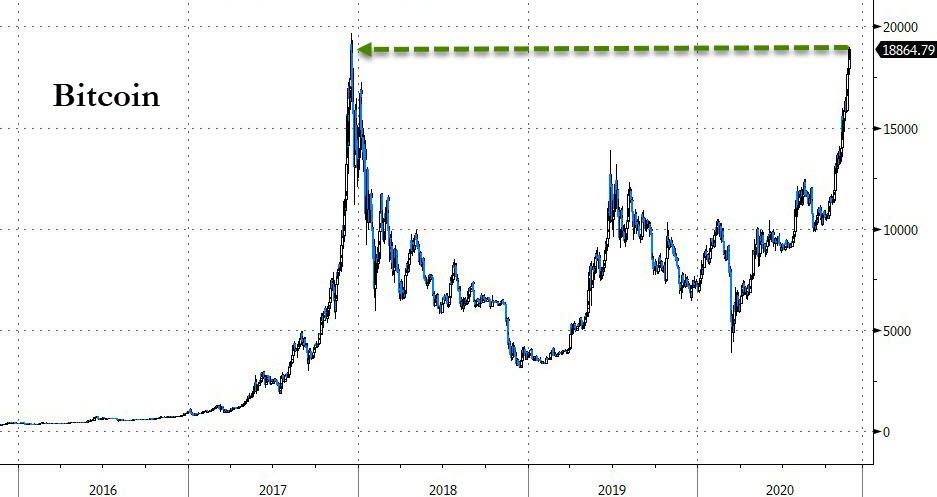
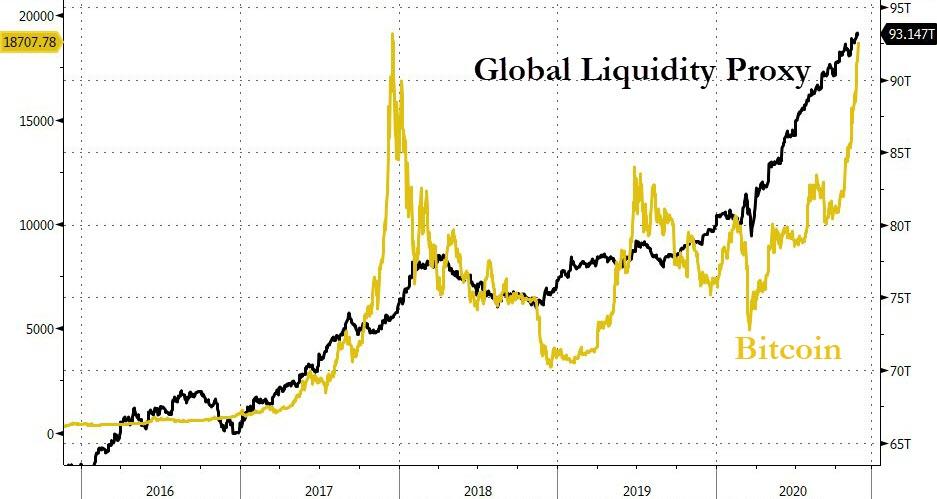
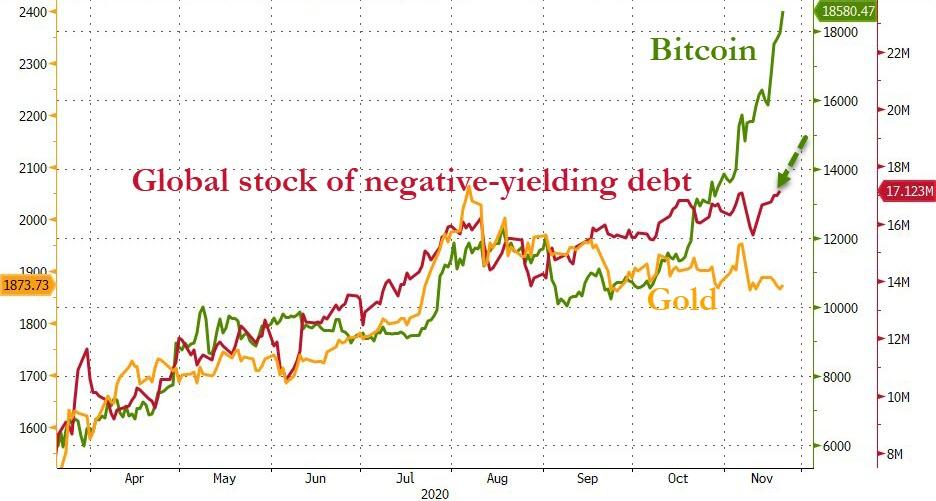
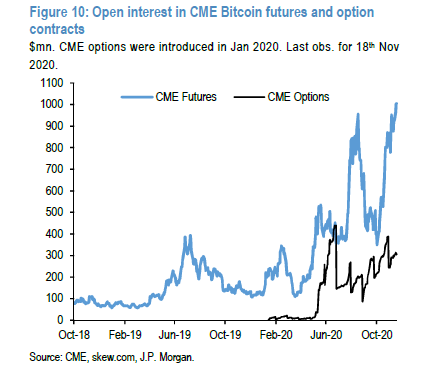
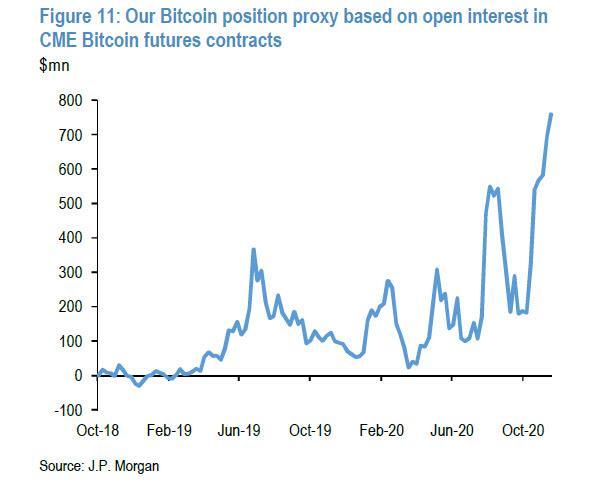
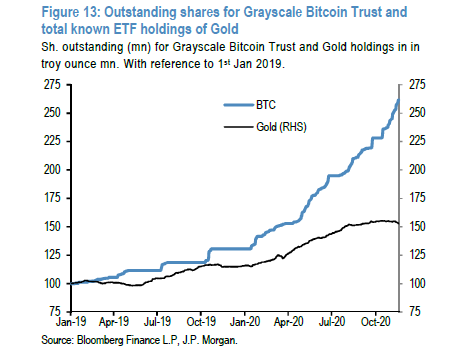
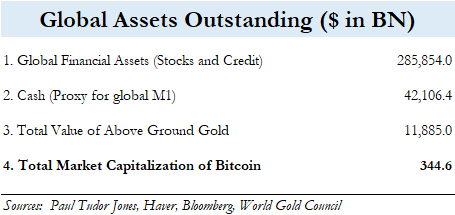
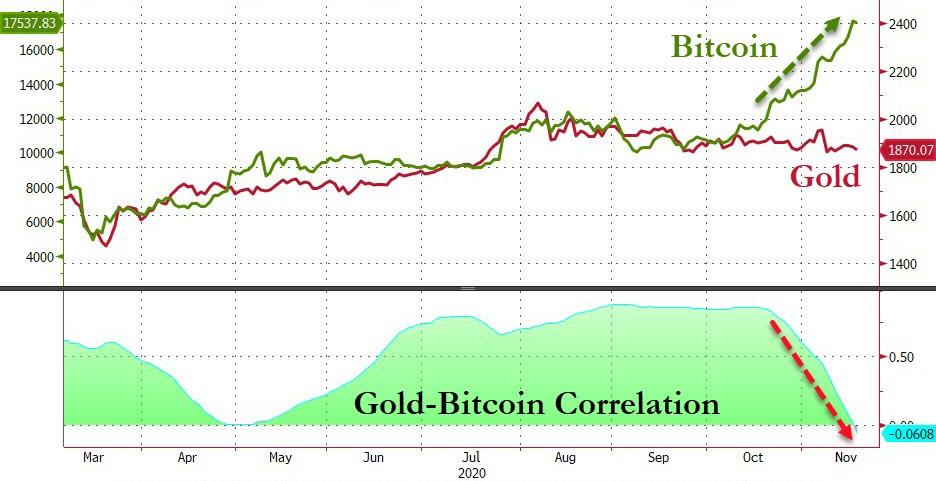
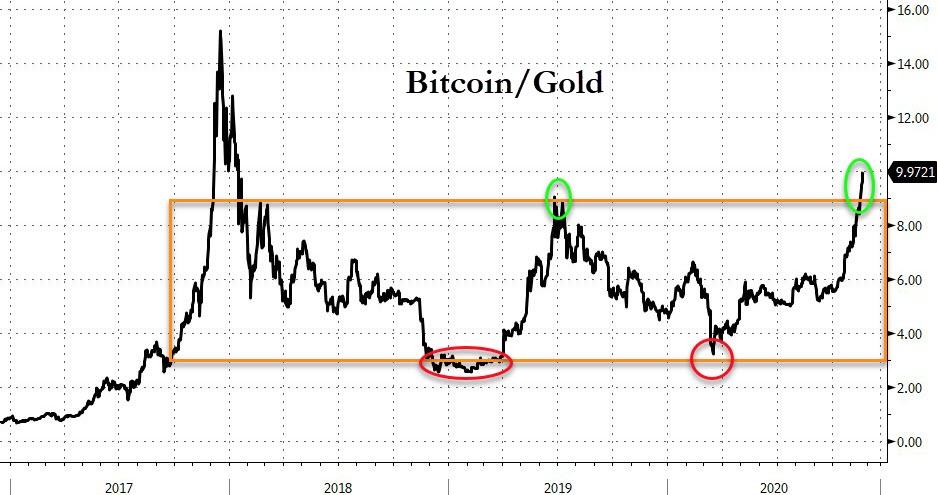
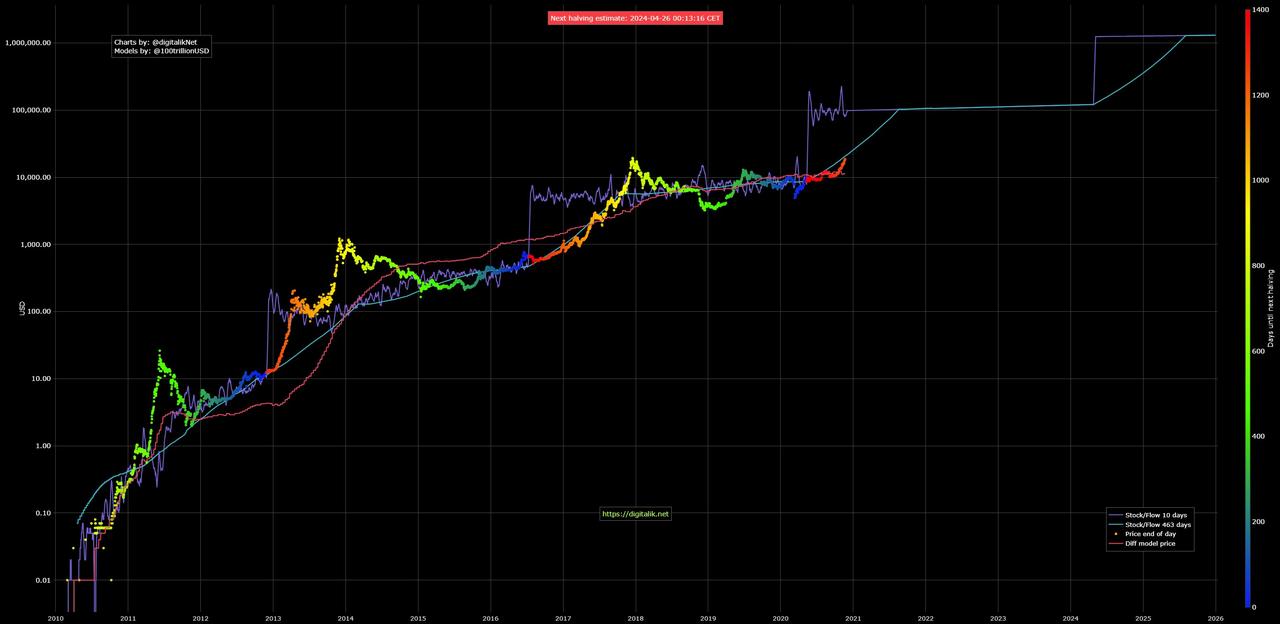
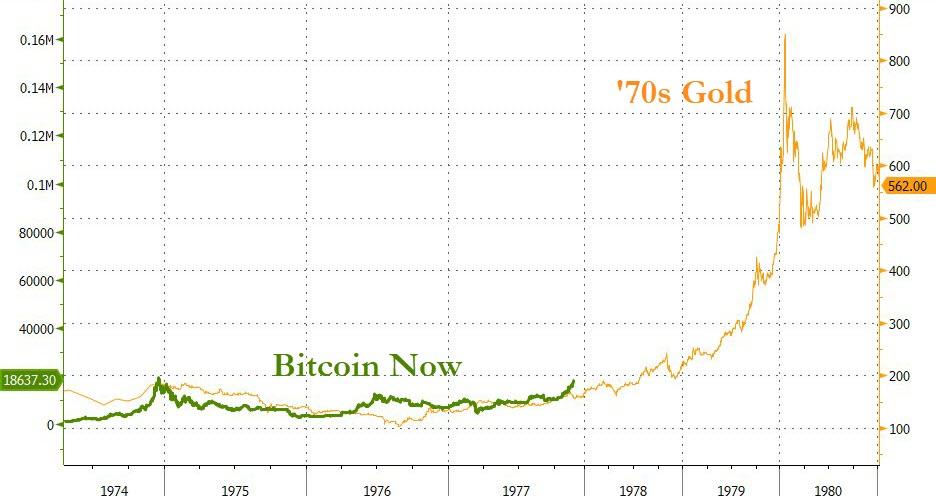



The one question not really answered is about what form of physical wealth backs BitCoin? It used to be that the dollar was backed by gold, until that standard was abandoned to assist the rise of inflation. So what form of physical wealth? Or is it just an agreement, which will hold as long as it is convenient, but can evaporate if a disagreement arises.
Perhaps an examination of the problems with having local currency prior to the federal creation of our dollars system should be in order. I see a similarity.